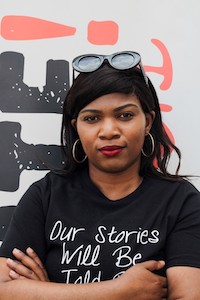I think it’s deeply unsettling how social media has amplified awareness of gender-based violence in South Africa, becoming a catalyst in GBV cases and carving new pathways for processing these tragedies
Our digital timeline of national trauma unfolds like episodes in a series we never wanted to watch. In 2019, our feeds filled with images of Uyinene Mrwetyana’s bright smile as we learned of her brutal murder (Sokanyile, 2019).
A year later came headlines about Tshegofatso Pule, eight months pregnant, found in Roodepoort (Shange, 2020). In 2023, we mourned Namhla Mtwa through painful updates shared across platforms (Maphanga, 2023). Now in 2025, our TikTok pages update us on Cwecwe Mhlangala as her family navigates her case (Cele, 2025).
These digital spaces have become forums of witness and pathways to justice where evidence surfaces and voices join in solidarity. Our platforms now serve as both everyday connection spaces and last resorts for families seeking justice when traditional systems fail them.
Through this wave, we’ve learned names otherwise lost to statistics – women whose stories reached us through hashtags, whose lives mattered enough for us to carry their memory from screens to streets.
The nature of digital activism
Before tweets and Instagram stories capture public attention, there’s always the raw reality of each case. A daughter, sister, or friend doesn’t return home, becomes another entry in the SAPS database. Those close to the loved one report to the police, complete forms and follow every procedure.
And then, they wait
…And wait
…And wait.
The Sonke Gender Justice annual report shows prosecution rates for GBV crimes remain under 8% (Sonke Gender Justice, 2024). These numbers represent thousands of cases where justice remains elusive, demonstrating how our system fails those it claims to defend.
Police responses follow a troubling pattern. Rarely is action swift; more commonly, what unfolds is what I like to call ‘institutional dawdling’ – administrative slowdowns, procedural hoops and a lack of urgency. This often stems from resource limitations: understaffed stations and exhausted investigators balancing multiple roles without proper training.
Other times, it’s the bureaucratic maze – reports disappear, cases move between stations, and families repeatedly provide statements that should have been collected earlier. Behind this lies the disturbing reality: violence against women has become so normalised that each case is processed with diminishing urgency.
I’ve seen it in the eyes of SAPS officers – that vacant stare communicating, “This is South Africa, what did you expect?” It can be subtle interrogations of victims’ choices or nonverbal cues insinuating “she was walking alone” or “she drank with these men”.
This isn’t just indifference but what happens when people face repeated trauma without support. This flatline response occurs when violence becomes so common we grow numb to its horror.
The thread of collective exhaustion
What stood out to me about Cwecwe’s case was how quiet it was initially. It didn’t make breaking news, nor was it trending. For months, it was just another case among many – until her mother shared the story on a podcast, overwhelmed with piercing pain.
Almost as if to say, “Say less” to her tears, the story emerged, and then virality did what it does best: it exploded. From TikTok to Instagram, timelines became flooded. You could post a dog, and someone would comment, #JusticeForCwecwe.
It was relentless and unapologetic. It embodied digital militancy – raw and untamed. It felt as though something had ruptured deep within our collective spirit. We were no longer just angry; we were done. Even though we had never met her, we marched and organised, demanding justice with a deep ancestral voice. The internet seemed to echo the cries of every child who had been failed by the justice system.
It reminded me so much of #FeesMustFall.
What began as the #RhodesMustFall movement quickly transformed into a nationwide uprising. The digital space provided us with a platform to be seen and heard, validating our experiences and confirming that we were not alone in our frustrations.
Movements are fragile things
Universities that had never communicated with one another suddenly found a common cause, holding the same placards and demanding similar changes. #RhodesMustFall joined forces with #OutsourcingMustFall, which in turn resonated with #WitsFeesMustFall. #StellenboschMustFall discovered solidarity with #UCTShutdown. We were loud, we were united, and for a moment, we felt unstoppable (Booysen, 2023).
But movements are fragile things.
For every step forward, there were arrests. For every press conference that yielded unsatisfactory results from the government, there was a sense of demoralisation. For every breakthrough, someone faced suspension, injury or trauma.
We occupied libraries and student centres, dodged rubber bullets, and covered our faces with cloths to avoid the sting of tear gas. We debated strategies while mourning the loss of our innocence. The bureaucracy wore us down.
Meetings with government and university officials often led to no results, with promises of transformation turning into delayed implementations. Amid campus shutdowns, our only weapon were our voices.
And then, almost subtly, the resistance flickered. It didn’t happen in a moment, but through an accrual of small surrenders, we even sprinkled terms for it, ‘strategic retreats’. The fire we once all had, died, I recall looking at comrades, and myself thinking, what happened to us?
Bodies that once stood tall at the frontlines of marches, singing ‘Solomon’ with so much conviction, now hurried across campus, urgently needing to catch up with lectures and assignments – rushing through campuses we had once rendered ungovernable.
Nothing left to give
I digress. I now understand and hold space for all of us: it wasn’t that we no longer believed, but rather that we had nothing left to give.
I see this happening now with Cwecwe’s case. The hashtags that once galvanised support across platforms have quieted. The daily buzz has slowed. People are posting their trivial content in peace, and naturally, the media has moved on to newer tragedies. This isn’t a betrayal or forgetting; it’s the inevitable rhythm of movements that demand everything from people who have already given so much.
I still carry the weight of #FeesMustFall in my body – felt in random moments of triggers, in the tightness of my chest when I hear protest songs, or when I witness the crowd pouring out to march for Cwecwe. I have noticed the weight in the eyes of those posting, organising, and fighting for Cwecwe. It’s not just fatigue; it’s the crushing exhaustion of holding space for both hope and injustice.
We need to acknowledge this pattern not to justify it, but to find more sustainable ways of demanding justice.
Beyond the digital surge
After the noise created by trending hashtags quiets down, another kind emerges for families – this is where you’ll find Cwecwe’s mother and many others, bearing the weight of seeking justice long after the world has moved on. For most, these stories are fleeting moments.
But for families affected, there’s no off switch; the responsibility lies with them to ensure justice is served.
We often mistake online discussions and trending topics for actual victories. However, when the digital noise fades, grieving families are left to complete the groundwork – answering media calls, reliving trauma, and battling through complex systems. Loudness is not synonymous with justice.
While social media can mobilise support, it cannot prosecute or lead to reform.
Movements like #RhodesMustFall demonstrate what is possible when digital expression evolves into tangible structural change (Booysen, 2023). Similarly, Generation G channels online momentum into grassroots strategies that drive genuine real-world justice (Mbembe, 2023).
Their Generation G Engage app serves as a beacon of sustainable activism – a platform created with young people and survivors in mind. It provides tools for monitoring gender-based violence cases within the justice system, educational resources, and a digital community space for collaboration and mobilisation.
By bridging the digital and the tangible, this app empowers youth and civil society to turn outrage into organised action, ensuring that justice is not only discussed online but actively pursued on the ground every day.
These intersectional strategies are not signs of confusion rather, they are evidence of our adaptation – demonstrating that we are learning to acknowledge both digital urgency and the need for systemic transformation simultaneously.
Toward sustainable justice
The challenge of sustainable activism regarding gender-based violence reveals significant difficulties within our diversified context. The collapse of the #FeesMustFall movement reminds us that even powerful movements can struggle under emotional strain.
What seemed like abandonment was a crisis of sustainability – a collective exhaustion that we bravely attempted to articulate. Current discussions often overlook the vital importance of self-preservation, creating false divides between commitment and survival.
The essential ‘quiet work’ of justice, including thorough documentation and follow-ups, often goes unrecognised but is crucial for supporting cases once public interest fades. Unfortunately, existing systems provide minimal support for this work, leading to burnout among activists.
To address this issue, we must focus on structural changes rather than solely on individual resilience. The tension between fleeting visibility and sustained advocacy calls for the media to follow cases beyond their viral moments and funding for long-term efforts.
We have the opportunity to create movements that honour human limitations and promote shared responsibility, preventing a few individuals from bearing the entire burden.
True transformation may arise not from dramatic displays of resistance but from those who steadfastly bear witness when attention dims down. Building infrastructures of care that can endure both initial surges of attention and subsequent silence is essential for achieving lasting justice and inspiring change.
 I’m Aphelele Mtwecu, a proud member of the Activate Change Drivers network and a 2016 Activator. I am a 33-year-old ambivert who works as a content writer, activist and creative. My true passion lies in youth development, transformation and making a meaningful impact. Every day, I encounter the world seeking healing, innovative solutions and fresh methods to drive social change on my personal journey. My work and advocacy reflect my unwavering commitment to fostering positive change.
I’m Aphelele Mtwecu, a proud member of the Activate Change Drivers network and a 2016 Activator. I am a 33-year-old ambivert who works as a content writer, activist and creative. My true passion lies in youth development, transformation and making a meaningful impact. Every day, I encounter the world seeking healing, innovative solutions and fresh methods to drive social change on my personal journey. My work and advocacy reflect my unwavering commitment to fostering positive change.
REFERENCES
Booysen, S. (2023). Fees Must Fall: Student revolt, decolonisation and governance in South Africa. Wits University Press.
Cele, N. (2025, March 12). Justice for Cwecwe: How South Africa’s newest GBV case broke social media. Mail & Guardian. [URL]
Department of Police. (2024). Annual crime statistics report 2023/2024. South African Police Service.
Maphanga, C. (2023, May 18). Namhla Mtwa: One year later, still no arrests in Eastern Cape woman’s murder. News24.
Mbembe, A. (2023). Digital activism and structural reform: Generation G’s impact on gender-based violence in South Africa. Journal of African Digital Studies, 12(2), 87-103.
Shange, N. (2020, June 10). Body of missing Tshegofatso Pule found hanging from tree, was eight months pregnant. TimesLIVE.
Sokanyile, A. (2019, September 2). Uyinene Mrwetyana murder: Post office worker confesses. IOL.
Sonke Gender Justice. (2024). Annual report 2023/2024.














